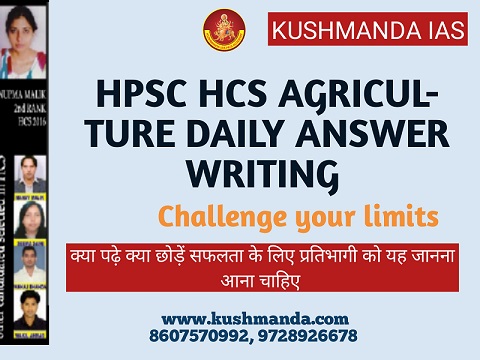HPSC HCS AGRICULTURE TEST SERIES DAILY ANSWER WRITING
HPSC HCS AGRICULTURE TEST SERIES DAILY ANSWER WRITING
HCS AGRICULTURE TEST SERIES DAILY ANSWER WRITING
| Sl. No. | Test No. | Topics to be Covered | Date |
| 1 | Test 1 | Ecology and its relevance to man, natural resources, their sustainable management and conservation. Physical
and social environment as factors of crop distribution and production. Agro ecology; cropping pattern as indicators of environments. Environmental pollution and associated hazards to crops, animals and humans. Climate change— International conventions and global initiatives. Green house effect and global warming. Advance tools for ecosystem analysis—Remote Sensing (RS) and Geographic Information Systems (GIS). Cropping patterns in different agro-climatic zones of the country. Impact of high-yielding and short-duration varieties on shifts in cropping patterns. Concepts of various cropping, and farming systems. Organic and Precision farming. Package of practices for production of important cereals, pulses, oil seeds, fibres, sugar, commercial and fodder crops. |
MONDAY |
| 2 | Test 2 | Important features, and scope of various types of forestry plantations such as social forestry, agro-forestry,
and natural forests: Propagation of forest plants. Forest products. Agro-forestry and value addition. Conservation of forest flora and fauna. Weeds, their characteristics, dissemination and association with various crops; their multiplications; cultural, biological, and chemical control of weeds. Soil—physical, chemical and biological properties. Processes and factors of soil formation. Soils of India. Mineral and organic constituents of soils and their role in maintaining soil productivity. Essential plant nutrients and other beneficial elements in soils and plants. Principles of soil fertility, soil testing and fertiliser recommendations, integrated nutrient management Biofertilizers. Losses of nitrogen in soil, nitrogen-use efficiency in submerged rice soils, nitrogen fixation in soils. Efficient phosphorus and potassium use. Problem soils and their reclamation. Soil factors affecting green house gas emission. Soil conservation, integrated watershed management. Soil erosion and its management. Dry land agriculture and its problems. Technology for stabilising agriculture production in rainfed areas. |
TUESDAY |
| 3 | Test 3 | Water-use efficiency in relation to crop production, criteria for scheduling irrigations, ways and means of
reducing run-off losses of irrigation water. Rainwater harvesting. Drip and sprinkler irrigation. Drainage of waterlogged soils, quality of irrigation water, effect of industrial effluents on soil and water pollution. Irrigation projects in
India. Farm management, scope, importance and characteristics, farm planning. Optimum resource use and budgeting. Economics of different types of farming systems. Marketing management strategies for development, market intelligence. Price fluctuations and their cost; role of co-operatives in agricultural economy; types and systems of farming and factors affecting them. Agricultural price policy. Crop Insurance. Agricultural extension, its importance and role, methods of evaluation of extension programmes, socio- economic survey and status of big, small and marginal farmers and landless agricultural labourers; Training programmes for extension workers. Role of Krishi Vigyan Kendra‘s (KVK) in dissemination of Agricultural technologies. Non-Government Organisation (NGO) and self-help group approach for rural development. |
WEDNESDAY |
| 4 | Test 4 | Cell structure, function and cell cycle. Synthesis, structure and function of genetic material. Laws of heredity.
Chromosome structure, chromosomal aberrations, linkage and cross-over, and their significance in recombination breeding. Polyploidy, euploids and aneuploids. Mutation—and their role in crop improvement. Heritability, sterility and incompatibility, classification and their application in crop improvement. Cytoplasmic inheritance, sex-linked, sex-influenced and sex-limited characters. History of plant breeding. Modes of reproduction, selfing and crossing techniques. Origin, evolution and domestication of crop plants, center of origin, law of homologous series, crop genetic resources—conservation and utilization. Application of principles of plant breeding, improvement of crop plants. Molecular markers and their application in plant improvement. Pure-line selection, pedigree, mass and recurrent selections, combining ability, its significance in plant breeding. Heterosis and its exploitation. Somatic hybridization. Breeding for disease and pest resistance. Role of interspecific and intergeneric hybridization. Role of genetic engineering and biotechnology in crop improvement Gernetically modified crop plants. |
THRUSDAY |
| 5 | Test 5 | Seed production and processing technologies. Seed certification, Seed testing and storage. DNA finger printing
and seed registration. Role of public and private sectors in seed production, and marketing. Intellectual Property Rights (IPR) issues, WTO issues and its impact on Agriculture. Principles of Plant Physiology with reference to plant nutrition, absorption, translocation and metabolism of nutrients. Soil-water-plant relationship. Enzymes and plant pigments; photosynthesis—modern concepts and factors affecting the process, aerobic and anaerobic respiration; C3, C4 and CAM mechanisms. Carbohydrate, protein and fat metabolism. Growth and development; photoperiodism and vernalization. Plant growth substances and their role in crop production. Physiology of seed development and germination; dormancy. Stress physiology—draught, salt and water stress. Major fruits, plantation crops, vegetables, spices and flower crops. Package practices of major horticultural crops. Protected cultivation and high tech horticulture. Post-harvest technology and value addition of fruits and vegetables. Landscaping and commercial floriculture. Medicinal and aromatic plants. Role of fruits and vegetables in human nutrition. |
FRIDAY |
| 6 | Test 6 | Diagnosis of pests and diseases of field crops, vegetables, orchard and plantation crops and their economic
importance. Classification of pests and diseases and their management. Intergrated pest and diseases management. Storage pests and their management. Biological control of pests and diseases. Epidemiology and forecasting of major crop pests and diseases. Plant quarantine measures. Pesticides, their formulation and modes of action. Food production and consumption trends in India. Food security and growing population—vision 2020. Reasons for grain surplus. National and International food policies. Production, procurement, distribution constraints. Availability of food grains, per capita expenditure on food. Trends in poverty, Public Distribution System and Below Poverty Line population, Targeted Public Distribution System (PDS), policy implementation in context to globalization. Processing constraints. Relation of food production to National Dietary Guidelines and food consumption pattern. Food based dietary approaches to eliminate hunger. Nutrient deficiency—Micro nutrient deficiency: Protein Energy Malnutrition or Protein Calorie Malnutrition (PEM or PCM), Micro nutrient deficiency and HRD in context of work capacity of women and children. Food grain productivity and food security. |
SATURDAY |
| 7 | Test 7 | FULL TEST | SUNDAY |
HCS AGRICULTURE TEST SERIES DAILY ANSWER WRITING
| Sl. No. | Test No. | Topics to be Covered | Date |
| 1 | Test 1 | Ecology and its relevance to man, natural resources, their sustainable management and conservation. Physical
and social environment as factors of crop distribution and production. Agro ecology; cropping pattern as indicators of environments. Environmental pollution and associated hazards to crops, animals and humans. Climate change— International conventions and global initiatives. Green house effect and global warming. Advance tools for ecosystem analysis—Remote Sensing (RS) and Geographic Information Systems (GIS). Cropping patterns in different agro-climatic zones of the country. Impact of high-yielding and short-duration varieties on shifts in cropping patterns. Concepts of various cropping, and farming systems. Organic and Precision farming. Package of practices for production of important cereals, pulses, oil seeds, fibres, sugar, commercial and fodder crops. |
MONDAY |
| 2 | Test 2 | Important features, and scope of various types of forestry plantations such as social forestry, agro-forestry,
and natural forests: Propagation of forest plants. Forest products. Agro-forestry and value addition. Conservation of forest flora and fauna. Weeds, their characteristics, dissemination and association with various crops; their multiplications; cultural, biological, and chemical control of weeds. Soil—physical, chemical and biological properties. Processes and factors of soil formation. Soils of India. Mineral and organic constituents of soils and their role in maintaining soil productivity. Essential plant nutrients and other beneficial elements in soils and plants. Principles of soil fertility, soil testing and fertiliser recommendations, integrated nutrient management Biofertilizers. Losses of nitrogen in soil, nitrogen-use efficiency in submerged rice soils, nitrogen fixation in soils. Efficient phosphorus and potassium use. Problem soils and their reclamation. Soil factors affecting green house gas emission. Soil conservation, integrated watershed management. Soil erosion and its management. Dry land agriculture and its problems. Technology for stabilising agriculture production in rainfed areas. |
TUESDAY |
| 3 | Test 3 | Water-use efficiency in relation to crop production, criteria for scheduling irrigations, ways and means of
reducing run-off losses of irrigation water. Rainwater harvesting. Drip and sprinkler irrigation. Drainage of waterlogged soils, quality of irrigation water, effect of industrial effluents on soil and water pollution. Irrigation projects in
India. Farm management, scope, importance and characteristics, farm planning. Optimum resource use and budgeting. Economics of different types of farming systems. Marketing management strategies for development, market intelligence. Price fluctuations and their cost; role of co-operatives in agricultural economy; types and systems of farming and factors affecting them. Agricultural price policy. Crop Insurance. Agricultural extension, its importance and role, methods of evaluation of extension programmes, socio- economic survey and status of big, small and marginal farmers and landless agricultural labourers; Training programmes for extension workers. Role of Krishi Vigyan Kendra‘s (KVK) in dissemination of Agricultural technologies. Non-Government Organisation (NGO) and self-help group approach for rural development. |
WEDNESDAY |
| 4 | Test 4 | Cell structure, function and cell cycle. Synthesis, structure and function of genetic material. Laws of heredity.
Chromosome structure, chromosomal aberrations, linkage and cross-over, and their significance in recombination breeding. Polyploidy, euploids and aneuploids. Mutation—and their role in crop improvement. Heritability, sterility and incompatibility, classification and their application in crop improvement. Cytoplasmic inheritance, sex-linked, sex-influenced and sex-limited characters. History of plant breeding. Modes of reproduction, selfing and crossing techniques. Origin, evolution and domestication of crop plants, center of origin, law of homologous series, crop genetic resources—conservation and utilization. Application of principles of plant breeding, improvement of crop plants. Molecular markers and their application in plant improvement. Pure-line selection, pedigree, mass and recurrent selections, combining ability, its significance in plant breeding. Heterosis and its exploitation. Somatic hybridization. Breeding for disease and pest resistance. Role of interspecific and intergeneric hybridization. Role of genetic engineering and biotechnology in crop improvement Gernetically modified crop plants. |
THRUSDAY |
| 5 | Test 5 | Seed production and processing technologies. Seed certification, Seed testing and storage. DNA finger printing
and seed registration. Role of public and private sectors in seed production, and marketing. Intellectual Property Rights (IPR) issues, WTO issues and its impact on Agriculture. Principles of Plant Physiology with reference to plant nutrition, absorption, translocation and metabolism of nutrients. Soil-water-plant relationship. Enzymes and plant pigments; photosynthesis—modern concepts and factors affecting the process, aerobic and anaerobic respiration; C3, C4 and CAM mechanisms. Carbohydrate, protein and fat metabolism. Growth and development; photoperiodism and vernalization. Plant growth substances and their role in crop production. Physiology of seed development and germination; dormancy. Stress physiology—draught, salt and water stress. Major fruits, plantation crops, vegetables, spices and flower crops. Package practices of major horticultural crops. Protected cultivation and high tech horticulture. Post-harvest technology and value addition of fruits and vegetables. Landscaping and commercial floriculture. Medicinal and aromatic plants. Role of fruits and vegetables in human nutrition. |
FRIDAY |
| 6 | Test 6 | Diagnosis of pests and diseases of field crops, vegetables, orchard and plantation crops and their economic
importance. Classification of pests and diseases and their management. Intergrated pest and diseases management. Storage pests and their management. Biological control of pests and diseases. Epidemiology and forecasting of major crop pests and diseases. Plant quarantine measures. Pesticides, their formulation and modes of action. Food production and consumption trends in India. Food security and growing population—vision 2020. Reasons for grain surplus. National and International food policies. Production, procurement, distribution constraints. Availability of food grains, per capita expenditure on food. Trends in poverty, Public Distribution System and Below Poverty Line population, Targeted Public Distribution System (PDS), policy implementation in context to globalization. Processing constraints. Relation of food production to National Dietary Guidelines and food consumption pattern. Food based dietary approaches to eliminate hunger. Nutrient deficiency—Micro nutrient deficiency: Protein Energy Malnutrition or Protein Calorie Malnutrition (PEM or PCM), Micro nutrient deficiency and HRD in context of work capacity of women and children. Food grain productivity and food security. |
SATURDAY |
| 7 | Test 7 | FULL TEST | SUNDAY |
HCS AGRICULTURE TEST SERIES DAILY ANSWER WRITING
| Sl. No. | Test No. | Topics to be Covered | Date |
| 1 | Test 1 | Ecology and its relevance to man, natural resources, their sustainable management and conservation. Physical
and social environment as factors of crop distribution and production. Agro ecology; cropping pattern as indicators of environments. Environmental pollution and associated hazards to crops, animals and humans. Climate change— International conventions and global initiatives. Green house effect and global warming. Advance tools for ecosystem analysis—Remote Sensing (RS) and Geographic Information Systems (GIS). Cropping patterns in different agro-climatic zones of the country. Impact of high-yielding and short-duration varieties on shifts in cropping patterns. Concepts of various cropping, and farming systems. Organic and Precision farming. Package of practices for production of important cereals, pulses, oil seeds, fibres, sugar, commercial and fodder crops. |
MONDAY |
| 2 | Test 2 | Important features, and scope of various types of forestry plantations such as social forestry, agro-forestry,
and natural forests: Propagation of forest plants. Forest products. Agro-forestry and value addition. Conservation of forest flora and fauna. Weeds, their characteristics, dissemination and association with various crops; their multiplications; cultural, biological, and chemical control of weeds. Soil—physical, chemical and biological properties. Processes and factors of soil formation. Soils of India. Mineral and organic constituents of soils and their role in maintaining soil productivity. Essential plant nutrients and other beneficial elements in soils and plants. Principles of soil fertility, soil testing and fertiliser recommendations, integrated nutrient management Biofertilizers. Losses of nitrogen in soil, nitrogen-use efficiency in submerged rice soils, nitrogen fixation in soils. Efficient phosphorus and potassium use. Problem soils and their reclamation. Soil factors affecting green house gas emission. Soil conservation, integrated watershed management. Soil erosion and its management. Dry land agriculture and its problems. Technology for stabilising agriculture production in rainfed areas. |
TUESDAY |
| 3 | Test 3 | Water-use efficiency in relation to crop production, criteria for scheduling irrigations, ways and means of
reducing run-off losses of irrigation water. Rainwater harvesting. Drip and sprinkler irrigation. Drainage of waterlogged soils, quality of irrigation water, effect of industrial effluents on soil and water pollution. Irrigation projects in
India. Farm management, scope, importance and characteristics, farm planning. Optimum resource use and budgeting. Economics of different types of farming systems. Marketing management strategies for development, market intelligence. Price fluctuations and their cost; role of co-operatives in agricultural economy; types and systems of farming and factors affecting them. Agricultural price policy. Crop Insurance. Agricultural extension, its importance and role, methods of evaluation of extension programmes, socio- economic survey and status of big, small and marginal farmers and landless agricultural labourers; Training programmes for extension workers. Role of Krishi Vigyan Kendra‘s (KVK) in dissemination of Agricultural technologies. Non-Government Organisation (NGO) and self-help group approach for rural development. |
WEDNESDAY |
| 4 | Test 4 | Cell structure, function and cell cycle. Synthesis, structure and function of genetic material. Laws of heredity.
Chromosome structure, chromosomal aberrations, linkage and cross-over, and their significance in recombination breeding. Polyploidy, euploids and aneuploids. Mutation—and their role in crop improvement. Heritability, sterility and incompatibility, classification and their application in crop improvement. Cytoplasmic inheritance, sex-linked, sex-influenced and sex-limited characters. History of plant breeding. Modes of reproduction, selfing and crossing techniques. Origin, evolution and domestication of crop plants, center of origin, law of homologous series, crop genetic resources—conservation and utilization. Application of principles of plant breeding, improvement of crop plants. Molecular markers and their application in plant improvement. Pure-line selection, pedigree, mass and recurrent selections, combining ability, its significance in plant breeding. Heterosis and its exploitation. Somatic hybridization. Breeding for disease and pest resistance. Role of interspecific and intergeneric hybridization. Role of genetic engineering and biotechnology in crop improvement Gernetically modified crop plants. |
THRUSDAY |
| 5 | Test 5 | Seed production and processing technologies. Seed certification, Seed testing and storage. DNA finger printing
and seed registration. Role of public and private sectors in seed production, and marketing. Intellectual Property Rights (IPR) issues, WTO issues and its impact on Agriculture. Principles of Plant Physiology with reference to plant nutrition, absorption, translocation and metabolism of nutrients. Soil-water-plant relationship. Enzymes and plant pigments; photosynthesis—modern concepts and factors affecting the process, aerobic and anaerobic respiration; C3, C4 and CAM mechanisms. Carbohydrate, protein and fat metabolism. Growth and development; photoperiodism and vernalization. Plant growth substances and their role in crop production. Physiology of seed development and germination; dormancy. Stress physiology—draught, salt and water stress. Major fruits, plantation crops, vegetables, spices and flower crops. Package practices of major horticultural crops. Protected cultivation and high tech horticulture. Post-harvest technology and value addition of fruits and vegetables. Landscaping and commercial floriculture. Medicinal and aromatic plants. Role of fruits and vegetables in human nutrition. |
FRIDAY |
| 6 | Test 6 | Diagnosis of pests and diseases of field crops, vegetables, orchard and plantation crops and their economic
importance. Classification of pests and diseases and their management. Intergrated pest and diseases management. Storage pests and their management. Biological control of pests and diseases. Epidemiology and forecasting of major crop pests and diseases. Plant quarantine measures. Pesticides, their formulation and modes of action. Food production and consumption trends in India. Food security and growing population—vision 2020. Reasons for grain surplus. National and International food policies. Production, procurement, distribution constraints. Availability of food grains, per capita expenditure on food. Trends in poverty, Public Distribution System and Below Poverty Line population, Targeted Public Distribution System (PDS), policy implementation in context to globalization. Processing constraints. Relation of food production to National Dietary Guidelines and food consumption pattern. Food based dietary approaches to eliminate hunger. Nutrient deficiency—Micro nutrient deficiency: Protein Energy Malnutrition or Protein Calorie Malnutrition (PEM or PCM), Micro nutrient deficiency and HRD in context of work capacity of women and children. Food grain productivity and food security. |
SATURDAY |
| 7 | Test 7 | FULL TEST | SUNDAY |
HCS AGRICULTURE TEST SERIES DAILY ANSWER WRITING
| Sl. No. | Test No. | Topics to be Covered | Date |
| 1 | Test 1 | Ecology and its relevance to man, natural resources, their sustainable management and conservation. Physical
and social environment as factors of crop distribution and production. Agro ecology; cropping pattern as indicators of environments. Environmental pollution and associated hazards to crops, animals and humans. Climate change— International conventions and global initiatives. Green house effect and global warming. Advance tools for ecosystem analysis—Remote Sensing (RS) and Geographic Information Systems (GIS). Cropping patterns in different agro-climatic zones of the country. Impact of high-yielding and short-duration varieties on shifts in cropping patterns. Concepts of various cropping, and farming systems. Organic and Precision farming. Package of practices for production of important cereals, pulses, oil seeds, fibres, sugar, commercial and fodder crops. |
MONDAY |
| 2 | Test 2 | Important features, and scope of various types of forestry plantations such as social forestry, agro-forestry,
and natural forests: Propagation of forest plants. Forest products. Agro-forestry and value addition. Conservation of forest flora and fauna. Weeds, their characteristics, dissemination and association with various crops; their multiplications; cultural, biological, and chemical control of weeds. Soil—physical, chemical and biological properties. Processes and factors of soil formation. Soils of India. Mineral and organic constituents of soils and their role in maintaining soil productivity. Essential plant nutrients and other beneficial elements in soils and plants. Principles of soil fertility, soil testing and fertiliser recommendations, integrated nutrient management Biofertilizers. Losses of nitrogen in soil, nitrogen-use efficiency in submerged rice soils, nitrogen fixation in soils. Efficient phosphorus and potassium use. Problem soils and their reclamation. Soil factors affecting green house gas emission. Soil conservation, integrated watershed management. Soil erosion and its management. Dry land agriculture and its problems. Technology for stabilising agriculture production in rainfed areas. |
TUESDAY |
| 3 | Test 3 | Water-use efficiency in relation to crop production, criteria for scheduling irrigations, ways and means of
reducing run-off losses of irrigation water. Rainwater harvesting. Drip and sprinkler irrigation. Drainage of waterlogged soils, quality of irrigation water, effect of industrial effluents on soil and water pollution. Irrigation projects in
India. Farm management, scope, importance and characteristics, farm planning. Optimum resource use and budgeting. Economics of different types of farming systems. Marketing management strategies for development, market intelligence. Price fluctuations and their cost; role of co-operatives in agricultural economy; types and systems of farming and factors affecting them. Agricultural price policy. Crop Insurance. Agricultural extension, its importance and role, methods of evaluation of extension programmes, socio- economic survey and status of big, small and marginal farmers and landless agricultural labourers; Training programmes for extension workers. Role of Krishi Vigyan Kendra‘s (KVK) in dissemination of Agricultural technologies. Non-Government Organisation (NGO) and self-help group approach for rural development. |
WEDNESDAY |
| 4 | Test 4 | Cell structure, function and cell cycle. Synthesis, structure and function of genetic material. Laws of heredity.
Chromosome structure, chromosomal aberrations, linkage and cross-over, and their significance in recombination breeding. Polyploidy, euploids and aneuploids. Mutation—and their role in crop improvement. Heritability, sterility and incompatibility, classification and their application in crop improvement. Cytoplasmic inheritance, sex-linked, sex-influenced and sex-limited characters. History of plant breeding. Modes of reproduction, selfing and crossing techniques. Origin, evolution and domestication of crop plants, center of origin, law of homologous series, crop genetic resources—conservation and utilization. Application of principles of plant breeding, improvement of crop plants. Molecular markers and their application in plant improvement. Pure-line selection, pedigree, mass and recurrent selections, combining ability, its significance in plant breeding. Heterosis and its exploitation. Somatic hybridization. Breeding for disease and pest resistance. Role of interspecific and intergeneric hybridization. Role of genetic engineering and biotechnology in crop improvement Gernetically modified crop plants. |
THRUSDAY |
| 5 | Test 5 | Seed production and processing technologies. Seed certification, Seed testing and storage. DNA finger printing
and seed registration. Role of public and private sectors in seed production, and marketing. Intellectual Property Rights (IPR) issues, WTO issues and its impact on Agriculture. Principles of Plant Physiology with reference to plant nutrition, absorption, translocation and metabolism of nutrients. Soil-water-plant relationship. Enzymes and plant pigments; photosynthesis—modern concepts and factors affecting the process, aerobic and anaerobic respiration; C3, C4 and CAM mechanisms. Carbohydrate, protein and fat metabolism. Growth and development; photoperiodism and vernalization. Plant growth substances and their role in crop production. Physiology of seed development and germination; dormancy. Stress physiology—draught, salt and water stress. Major fruits, plantation crops, vegetables, spices and flower crops. Package practices of major horticultural crops. Protected cultivation and high tech horticulture. Post-harvest technology and value addition of fruits and vegetables. Landscaping and commercial floriculture. Medicinal and aromatic plants. Role of fruits and vegetables in human nutrition. |
FRIDAY |
| 6 | Test 6 | Diagnosis of pests and diseases of field crops, vegetables, orchard and plantation crops and their economic
importance. Classification of pests and diseases and their management. Intergrated pest and diseases management. Storage pests and their management. Biological control of pests and diseases. Epidemiology and forecasting of major crop pests and diseases. Plant quarantine measures. Pesticides, their formulation and modes of action. Food production and consumption trends in India. Food security and growing population—vision 2020. Reasons for grain surplus. National and International food policies. Production, procurement, distribution constraints. Availability of food grains, per capita expenditure on food. Trends in poverty, Public Distribution System and Below Poverty Line population, Targeted Public Distribution System (PDS), policy implementation in context to globalization. Processing constraints. Relation of food production to National Dietary Guidelines and food consumption pattern. Food based dietary approaches to eliminate hunger. Nutrient deficiency—Micro nutrient deficiency: Protein Energy Malnutrition or Protein Calorie Malnutrition (PEM or PCM), Micro nutrient deficiency and HRD in context of work capacity of women and children. Food grain productivity and food security. |
SATURDAY |
| 7 | Test 7 | FULL TEST | SUNDAY |
Fee: Rs 6000/-
Trust, quality and reliability the bywords for KUSHMANDA IAS HCS ACADEMY will remain our guiding force for both Preliminary as well as Main Exam.
How to send request:Only one single call on our helpline number 08607570992,09728926678
“Making good decisions is a crucial skill at every level. You should not waste this opportunity for just a sake of only appearing the examination. Give this attempt with the full fire. So join us immediately.”
Helpline: 08607570992, 09728926678
kushmandaeducation@gmail.com
Or call us 08607570992,09728926678
FINAL SELECTION IN HCS
MANAV MALIK (BAHADURGARH)
ANUPMA MALIK(PANIPAT)
BHARAT PARMAR(BHIWANI)
SEEMA SAINI(KURUKSHETRA)
WAKIL AHMAD(MEWAT)
ABHISHEK BATRA(KAITHAL)
VIRENDER BANSAL (AMBALA)
POOJA GOYAT( JIND)
PANKAJ DHANDA(HISAR)
JYOTI CHAHAL (ROHTAK)
What is the programme all about?
Mains Test Series provide platform for checking one’s preparation level as well as the status of time and speed management.
It gives aspirants an idea about writing an articulated answer in sync with the conceptual requirement of the question asked.
Programme consists of Total 28 Test
(a) Sectional Test : 24
(b) Mock Tests: 4
The numbers of tests are high as it will help the aspirant in covering whole syllabus in depth along with inter-disciplinary approach.
पूरा कार्यक्रम क्या है?
मेन्स टेस्ट सीरीज़ किसी की तैयारी के स्तर के साथ-साथ समय और गति प्रबंधन की स्थिति की जाँच के लिए मंच प्रदान करती है।
यह उम्मीदवारों को पूछे गए प्रश्न की वैचारिक आवश्यकता के अनुरूप एक स्पष्ट उत्तर लिखने के बारे में एक विचार देता है।
परीक्षणों की संख्या अधिक है क्योंकि यह अंतर-अनुशासनात्मक दृष्टिकोण के साथ-साथ पूरे पाठ्यक्रम को गहराई से कवर करने में आकांक्षी की मदद करेगा।
How is it different from other Test Series?
The trend and pattern of questions asked in HPSC changes each year. Predictability of pattern become difficult thus one should prepare holistically for the examination. This programme has been designed to cater that. Regular Test Series is mere inclined for answer writing only, however, this test series cover both concepts + answer writing practice.
It will cover tests under different heads:
Sectional Tests: This paper will be conducted Subject Wise. Each test designed to check the conceptual clarity and in depth understanding of the aspirant.
Mock Tests: Mock tests will be conducted on the line of HPSC pattern
यह अन्य टेस्ट सीरीज से कैसे अलग है?
एचपीएससी में पूछे जाने वाले प्रश्नों का रुझान और पैटर्न हर साल बदलता है। पैटर्न की भविष्यवाणी करना मुश्किल हो जाता है इसलिए परीक्षा के लिए समग्र रूप से तैयारी करनी चाहिए। इसी की पूर्ति के लिए यह कार्यक्रम तैयार किया गया है। नियमित टेस्ट सीरीज़ केवल उत्तर लेखन के लिए इच्छुक हैं, हालांकि, यह टेस्ट सीरीज़ दोनों अवधारणाओं + उत्तर लेखन अभ्यास को कवर करती है।
इसमें विभिन्न मदों के तहत परीक्षण शामिल होंगे:
सेक्शनल टेस्ट: यह पेपर सब्जेक्ट वाइज आयोजित किया जाएगा। प्रत्येक परीक्षण को वैचारिक स्पष्टता और आकांक्षी की गहराई से समझने के लिए डिज़ाइन किया गया है।
मॉक टेस्ट: एचपीएससी पैटर्न की तर्ज पर मॉक टेस्ट आयोजित किए जाएंगे
Who can join?
It is beneficial for both the fresher’s and experienced as it will provide broader scope for answer writing practice with respect to both Core Conceptual as well as inter-disciplinary approach of the syllabus.
कौन शामिल हो सकता है?
यह फ्रेशर और अनुभवी दोनों के लिए फायदेमंद है क्योंकि यह पाठ्यक्रम के मूल अवधारणात्मक और अंतर-अनुशासनात्मक दृष्टिकोण दोनों के संबंध में उत्तर लेखन अभ्यास के लिए व्यापक गुंजाइश प्रदान करेगा।
What is the importance of Model answers/synopsis?
Model answers/synopsis provide the information for a particular question, , the overall facts and concepts related to that topic asked in question is provided in detail. It shall be of immense help for the students in the revision of preparation before the exam.
मॉडल उत्तरों/सारांश का क्या महत्व है?
मॉडल उत्तर/सारांश किसी विशेष प्रश्न की जानकारी प्रदान करते हैं, प्रश्न में पूछे गए उस विषय से संबंधित समग्र तथ्य और अवधारणाएं विस्तार से प्रदान की जाती हैं। यह परीक्षा से पहले तैयारी के संशोधन में छात्रों के लिए बहुत मददगार होगा।
















